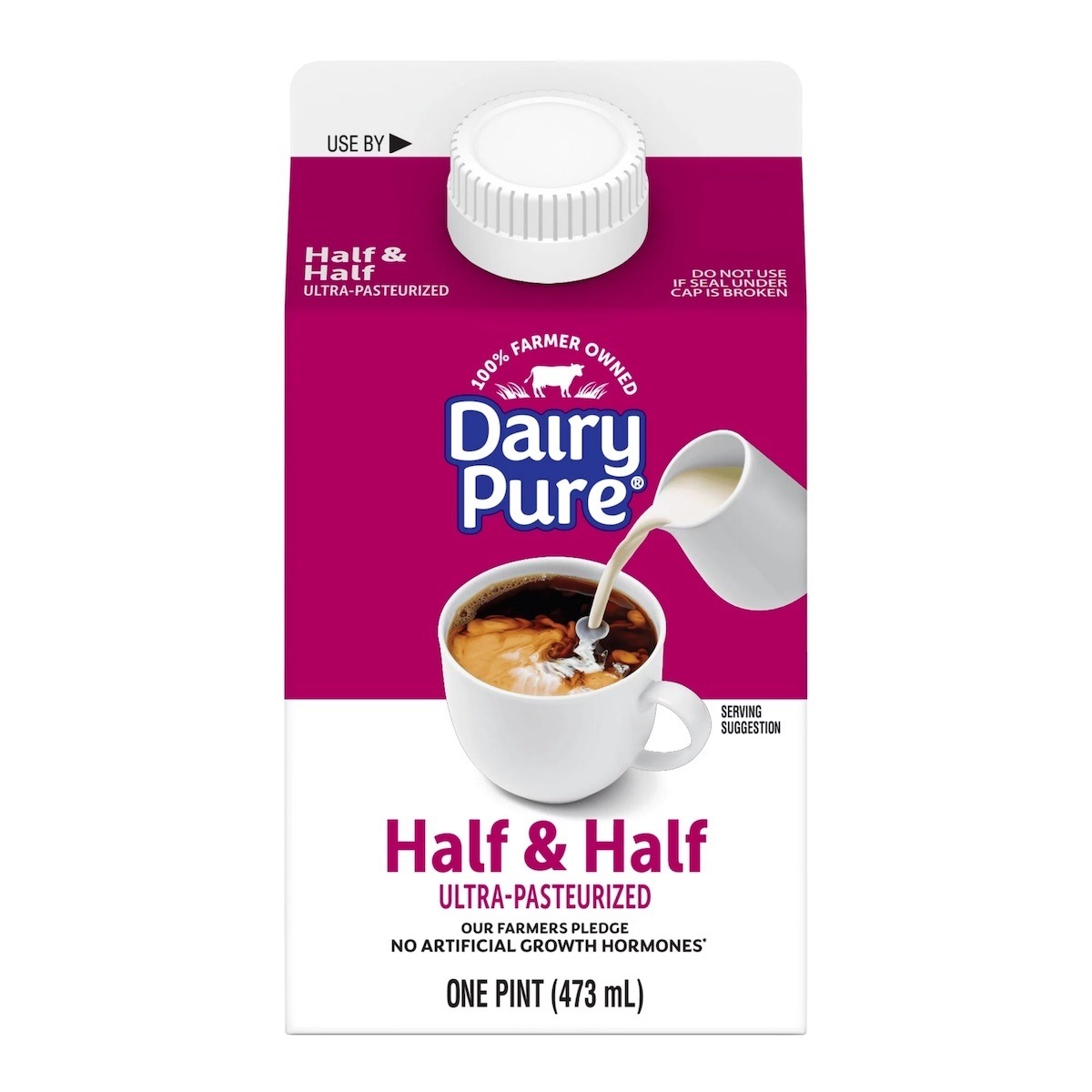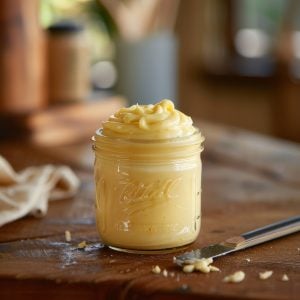What Is the Difference Between Cream, Heavy Cream, and Half and Half?
Let’s start with half and half because I get quite a few emails from people not living in the United States asking me about it when they see it in one of my recipes.
What is Half and Half?
Half and Half is a dairy product commonly used as a substitute for milk or cream in cooking and baking. It is a mixture of equal parts milk and cream, with a fat content of about 10-12%. Half and Half is a versatile ingredient used in various recipes, from coffee and tea to soups and sauces.
The origins of half and half can be traced back to the 19th century in England, where it was known as “cream mixture.” It was popularized in the United States in the early 20th century as a convenient way to add richness and flavor to coffee and tea without separating milk and cream.
Half and Half is commonly found in the dairy section of grocery stores, usually in small cartons or plastic containers. However, it can also be made at home by combining equal parts milk and heavy cream. The resulting mixture will have a slightly higher fat content than store-bought half and half, but the flavor and consistency will be similar.

Uses for Half and Half
One of the most popular uses for Half and Half is as a creamer for coffee and tea. It adds richness and a creamy texture without being too heavy or overpowering. In addition, many people prefer Half and Half over milk or cream because it is less likely to curdle or separate when added to hot liquids.
Half and Half is also a popular ingredient in cooking and baking. It can be used as a substitute for milk or cream in many recipes, such as soups, sauces, and casseroles. It adds a rich, creamy texture and a subtle flavor that can enhance the dish’s overall taste.
Recipes
One classic recipe that calls for Half and Half is New England clam chowder. This hearty soup is made with potatoes, onions, celery, and clams, all cooked in a creamy broth made with half and half. The Half and Half gives the soup a velvety texture and a slightly sweet flavor that complements the briny taste of the clams.
Another widespread use for half and half is in dessert recipes. It can be used as a base for ice cream, whipped cream, and custards, adding richness and a smooth, creamy texture. It can also be added to baked goods such as cakes and cookies to create a tender crumb and a moist texture.
Fat Content
Half and Half is a relatively low-fat dairy product compared to heavy cream, which has a fat content of about 35%. This makes it a good option for those who want to reduce their calorie intake but still enjoy the richness and creaminess of dairy products. However, it should be noted that half and half is not suitable for those who are lactose intolerant or have a milk allergy.
Is Half and Half Still Popular Outside of the United States?
While Half and Half is a popular dairy product in the United States, it may be less widely available or popular in other countries. As a result, in some countries, people may use a similar dairy product or a combination of milk and cream instead of half and half.
For example, in the United Kingdom, a similar dairy product called “single cream” is commonly used in cooking and baking. Single cream has a slightly lower fat content than half and half, around 18%, and is made by skimming the top layer of cream from fresh milk. It is used similarly to half and half as a substitute for milk or cream in recipes.
In France, a mixture of milk and heavy cream called “crème fraîche” is commonly used in cooking and baking. Crème fraîche has a much higher fat content than half and half, around 30-40%, and has a tangy flavor. It is often used in savory dishes such as sauces and soups but can also be used in desserts.
In many other countries, people may use a combination of milk and cream in recipes without a specific name or designation for the mixture. It all depends on the culinary traditions and preferences of each culture.
Why Not Just Use Cream?
While cream can be used in place of half and half in some recipes, there are several reasons why someone might choose to use half and half instead.
One of the main reasons is that cream has a much higher fat content than half and half, typically around 30-40% compared to 10-12%. This can make the cream a heavier and richer ingredient, which may be overpowering in some recipes. Half and half, however, provide a more balanced flavor and consistency without being too heavy.
Additionally, half and half is less likely to curdle or separate when heated than cream, making it a better choice for use in coffee or tea. However, the cream can sometimes curdle or form clumps when added to hot liquids, which can affect the texture and flavor of the beverage.
Another reason to use half and half instead of cream is to reduce a recipe’s overall calorie and fat content. Half and half has a lower fat content than cream, which makes it a healthier option for those who are watching their calorie intake or trying to reduce their fat consumption.
What Is the Definition of Cream?
Cream is a dairy product that separates milk’s high-fat content from the remaining liquid. It has a rich, smooth texture and a high-fat content, typically ranging from 18-40%. The fat content of cream can vary depending on the specific type of cream and how it is produced.
There are several types of cream, including heavy, light, whipping, and sour. Heavy cream has the highest fat content, typically around 36-40%, and is often used in desserts, sauces, and soups. Light cream has a lower fat content, around 18-20%, and is often used in coffee or tea.
Whipping cream, also known as double cream, has a fat content of around 30-36% and is often used to make whipped cream for desserts. Sour cream is made by fermenting cream with lactic acid bacteria, giving it a tangy flavor and thick texture.
Cream is a versatile ingredient that is used in a wide variety of recipes, including both sweet and savory dishes. It can be used to add richness and flavor to soups, sauces, and baked goods and can also be used as a topping for desserts or fruit.
What Is the Difference Between Cream and Heavy Cream?
Cream and heavy cream are dairy products made by separating the high-fat content of milk from the remaining liquid, but there are some differences between the two.
The main difference between cream and heavy cream is the fat content. Heavy cream has a higher fat content than regular cream, typically around 36-40%, while regular cream has a lower fat content, around 18-30%.
The higher fat content of heavy cream gives it a richer, thicker texture and a more luxurious mouthfeel than regular cream. Heavy cream is often used in baking and dessert recipes to add richness and flavor and can be whipped into whipped cream for toppings or fillings.
On the other hand, regular cream has a lighter texture and is often used in recipes where a lighter consistency is desired, such as in coffee or tea. It can also be used in sauces or soups to add richness without making the dish too heavy or thick.
It’s important to note that the terms “cream” and “heavy cream” may be used differently in different countries. Hence, it’s always a good idea to check the fat content of the cream you use to ensure you get the desired texture and flavor in your recipe.
How Are They Used Differently in Cooking?
Cream and heavy cream are versatile ingredients that can be used in various recipes, but they may be used differently in cooking due to their fat content and texture differences.
Heavy cream is often used in recipes where a rich, luxurious texture and flavor is desired. It can be used in sweet and savory dishes like sauces, soups, and casseroles. Heavy cream is also commonly used in baking, where it can be whipped into whipped cream for toppings or fillings or added to cakes, pies, and other desserts to add richness and flavor.
On the other hand, regular cream has a lighter texture and is often used in recipes with a lighter consistency. For example, it can be used in coffee or tea as a substitute for milk or as a base for creamy sauces or soups. Regular cream can also be used in desserts and baked goods, such as custards or puddings, where a lighter texture is desired.
It’s worth noting that the type of cream used in a recipe can affect the final texture and flavor, so it’s essential to choose the right type of cream for the desired result. For example, with its higher fat content, heavy cream may create a thicker and richer final product, while regular cream may create a lighter and more delicate final product.
How Is Cream Created from Cows’ Milk?
Cream is created by separating the high-fat content of milk from the remaining liquid. The process of creating cream from cow’s milk involves a few basic steps:
- Milk is collected from cows and is typically pasteurized to kill harmful bacteria.
- The milk is then allowed to sit in a tank or individual containers until the cream rises to the top. This is known as “ripening” the cream.
- Once the cream has risen to the top, it is skimmed off and separated from the rest of the milk. This can be done using a separator machine, ladle, or spoon to remove the cream.
- Depending on the desired final product, the cream can be processed further. For example, heavy cream may be left as is, while lighter creams may be blended with milk to create a lower fat content.
- The remaining liquid, which contains less fat than the cream, is known as skim milk and can be used in various other products.
Does Cream Taste Different from Different Kinds of Cows?
Yes, the taste of cream can vary depending on the breed of cows used to produce the milk. This is because different breeds of cows have different fat and protein compositions in their milk, which can affect the taste and texture of cream made from that milk.
For example, Jersey cows are known for producing milk with a higher fat content and a richer flavor, which can result in cream with a more intense flavor and thicker texture. In contrast, Holstein cows are known for producing milk with a lower fat content and a milder flavor, which can result in cream with a lighter flavor and thinner texture.

Diet
In addition to breed, the cows’ diet can also affect the taste of cream. For example, cows fed a grass and other forage diet may produce milk with a more complex flavor profile than cows fed a more grain-based diet.
While cream made from milk from different breeds of cows may have subtle differences in taste and texture, these differences are generally relatively minor. Therefore, they may not be noticeable to the average consumer. However, for those with a more discerning palate, the breed of cows and their diet may be factors to consider when choosing a cream for specific recipes.
Are Half and Half, Cream, or Heavy CreamUsed in Cheese Production?
Yes, half and half, cream, and heavy cream can all be used in cheese production, depending on the type of cheese being made and the specific recipe being followed.
Cream often produces soft and creamy cheeses, such as ricotta, cream cheese, and mascarpone. In these types of cheeses, cream is added to milk to increase the fat content and create a richer, creamier texture.
Heavy cream may be used to produce some types of cheese, such as feta and sour cream cheese. Heavy cream can also be used to make cultured butter, which is made by fermenting cream with bacteria.
Half and half, a mixture of cream and milk, may be used to produce some types of cheese, such as soft and spreadable cheeses. The lower fat content of half and half may result in a lighter, milder flavor in the final cheese.















